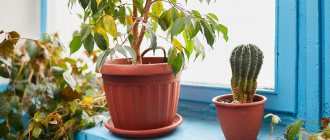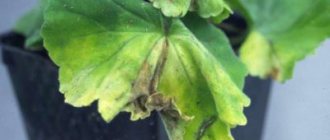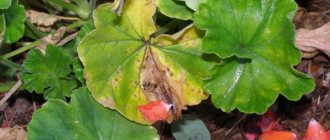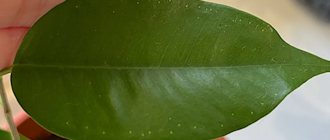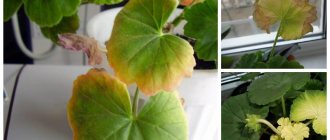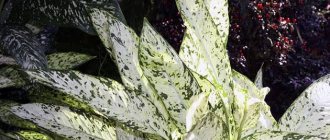There are many plants living in homes and offices. Each variety and type of indoor flowers has its fans. Some people love roses and ficus trees, while others like modest geraniums. When caring for home plantings, novice and experienced gardeners face various problems. Houseplants, instead of delighting with lush greenery and abundant flowering, begin to wither, become sick, and their leaves become dull and dry. Why the leaves of indoor flowers turn yellow - what to do in this case is described in this article.
Causes of yellowing leaves and ways to solve the problem
When the leaves of indoor plants turn yellow, before doing anything, you need to figure out the reasons. Every problem has its solution. The situation with yellowed leaves is aggravated by the fact that there are many reasons leading to such a sad result. Most often they require a comprehensive solution.
Cyclamen is one of the most interesting indoor plants
It is possible to restore the lost color of green leaves only after identifying the cause of yellowing and getting rid of it. Risk factors for why indoor flowers turn yellow are divided into two large groups:
- Violation of plant agrotechnics. These reasons are the most common. Especially for beginner gardeners. A change in leaf color is the plant’s very first reaction to improper care. Of course, each flower requires an individual approach. But since they are all kept in houses, the solutions for different types are often the same.
- Pests and diseases. They are dangerous because they can spread from one infected plant to others. Affected specimens must be urgently treated or, if the disease is incurable, destroyed.
Yellowed leaves
Below we discuss in detail the various causes of yellowing foliage and how to eliminate them.
Viruses in indoor plants
Houseplants are also susceptible to infections. This is one of the most unpleasant causes of yellowing leaves. If you see that the leaves of a plant have shriveled and turned yellow, then immediately isolate it from other plants, as the infection is a contagious disease. And all plants can become infected and die. This disease needs to be treated, but first find out what kind of “infection” has consumed your flower.
Mosaic disease
Dry air as a cause of yellowing
Why do daylily leaves turn yellow - what to do
Dry air is a winter problem. Dried by central heating radiators, it draws moisture from the leaves. Plants with thin, delicate leaves are the first to suffer. They turn yellow and dry out.
Attention! Maintaining optimal humidity is the key to good health and active flowering of indoor plants.
You can humidify the air with special household appliances and using devices made from scrap materials.
The problem can be solved by regular spraying, although this method is not suitable for plants with pubescent leaves, as well as begonias and some other species. A good option might be a container of water or wet expanded clay placed next to the pots.
The baby's leaves are turning yellow
Most often, yellowing of leaves in a baby occurs :
- In careless watering;
- Or as a result of sunburn.
You should not flood the root collar, but rather water along the edge of the container . The plant should not be exposed to direct sunlight. It is worth shading the growing area or changing the location of the orchid.
Yellowing can be caused by pests . A careful inspection through a magnifying glass will determine their presence. Young, tender baby leaves are a real delicacy for them. To avoid the appearance of pests, it is enough to carry out preventive treatment with an insecticide.
Important! The presence of pests should be checked immediately after purchasing the plant.
Insufficient watering
Why do rhododendron leaves turn yellow and what to do?
Yellowing of the tips of the leaves is a sure sign that the plant needs moisture. Even with regular watering and a substrate that is damp to the touch, it may happen that the roots do not receive enough water.
Using untreated water for irrigation can also cause yellowed leaves. Hard, unsettled tap water will cause plants to yellow and wilt.
Watering is carried out until water begins to appear in the pan. If the soil is very dry, you can water the flower by immersing the pot 2/3 in water for a while, allowing the water to saturate the entire lump.
Plant rust control agents
Chemical and biological drugs
Bordeaux mixture
A popular and time-tested fungicide. For early spring treatment on swelling buds and for spraying in late autumn, prepare a 3% solution. During the summer, plants are treated with a 1% solution.
Abiga Peak
Broad-spectrum fungicide. It contains copper, so it acts similarly to copper sulfate and Bordeaux mixture.
To spray plants, 40–50 g of the drug is diluted in 10 liters of water. Carry out 2-3 treatments with an interval of 10-14 days.
Topaz
Fast-acting systemic fungicide for the prevention and treatment of rust. The dosage of the drug to combat rust on trees, berry bushes, and vegetable crops is 2 g per 10 liters of water, for flowers – 3–4 g per 10 liters of water.
Strobe
Effective for both prevention and control of existing infection.
For fruit and vegetable crops, the consumption of the drug is 2 g per 10 liters of water, for flowers – 5 g per 10 liters. Strobi is used alternately with other fungicides. In total, it is used no more than 3 times per season.
Hom
Moderately toxic fungicide, safe for humans and animals. Compatible with other drugs. To prepare the solution, 30 g of powder is diluted in 10 liters of water.
Fitosporin
Biological fungicide. It is used to treat soil, seeds, and plants throughout the growing season.
For indoor and garden flowers, the dosage for prevention is 0.5 tsp. powder per 2 liters of water, for diseased plants - 0.5 tsp. drug per 1 liter of water. For spraying fruit, vegetable crops and berry bushes on a leaf: 5–6 g per 10 l of water or 3 tsp of concentrate per 10 l of water.
Traditional methods
Home methods are used for preventive purposes. They are safe and effective when used regularly.
- Dilute 1 part of the serum with 10 parts of water and spray on the leaves. This treatment protects against fungi and provides additional nutrition.
- Pour 1 part rotted cow manure into 3 parts water. Leave for 3 days, strain and spray on ornamental plants in the evening.
- 10 tablets of hydrogen peroxide, 5 g of boric acid. Boric acid is first diluted in a glass of hot water. Peroxide tablets are crushed and dissolved in a small amount of cold water. Afterwards, all components are mixed with 10 liters of water and sprayed on the plants.
Lack of lighting
Why do indoor balsam leaves turn yellow?
With a lack of light, the foliage of indoor flowers loses color unevenly, and often even falls off. This type of leaf fall is typical for hibiscus.
Attention! If the leaves turn yellow on only one side of the plant, this is a clear sign of lack of lighting.
Flowers will turn yellow if the pots are too far from the light source, or on window sills oriented north, northwest.
Light-loving plants especially suffer from a lack of sunlight. The lack of natural lighting is easily compensated for by artificial lighting. A lamp with a fluorescent lamp is suitable. Such lighting does not overheat the flower and consumes minimal energy.
Sometimes you can solve the problem by turning the yellowed part of the plant towards the light.
Reason 3. Lack or excess of sunlight
Each plant requires a certain amount of light for normal development. If norms are violated, problems begin. Due to lack of lighting, the leaves turn yellow, turn pale and fall off, the shoots become elongated, the buds do not open, and the flower loses its decorative appearance. Excessive light leads to sunburn, when leaves and other parts of the plant become covered with yellow and black spots.
How to set up proper lighting for plants
Before placing the pot on the windowsill, be sure to make sure that the orientation of the window suits the flower. Light-loving plants can be placed on a southern, southwestern or southeastern windowsill. But you will almost always need additional shading to avoid burns. What to shade? You can use paper, cardboard, gauze, tint film. On the western and eastern windows, flowers do not need to be shaded. But on the north window, additional illumination with fluorescent or phytolamps will most likely be needed. If you don’t want to bother yourself too much, choose unpretentious plants.
Rotate the flower pot from time to time so that all parts of the plant receive enough light.
Lack of fertilizers and nutrients in the soil
The lack of nutrients in the soil affects the metabolic processes of the plant. A deficiency of a particular substance can be determined by specific signs:
Feeding is important for indoor plants
- Nitrogen. A macronutrient, indoor flowers that grow for a long time in the same substrate suffer from its deficiency. The foliage becomes pale green or yellow, becomes smaller and withers.
- Calcium deficiency is determined by a specific yellowing of the tips of leaf blades.
- Magnesium. Its deficiency can be determined by small spots between the veins, which increase in size over time. If magnesium does not reach the plant at all, then the yellow color of the leaves turns into orange and red.
- Copper deficiency is similar to magnesium deficiency, but the symptoms include leaf wilting.
- A lack of manganese will result in leaves turning gray-yellow or yellow-green. This color will appear on the leaves of a plant planted in a substrate with a strong alkaline reaction.
- Molybdenum. The edges and areas between the veins turn yellow, while the leaves and petals curl - a signal of molybdenum starvation.
The problem of lack of nutrients in the soil is solved quite simply. The application of complex fertilizers, preferably containing elements in chelated form, will restore the greenness of flowers. When feeding, it is worth taking into account the characteristics of the plant and the phases of its life cycle. During active growth, the flower needs nitrogen, and during the flowering period - potassium and phosphorus.
Experienced gardeners advise using mineral fertilizers, as they are easier to dose and eliminate the risk of introducing parasites and diseases.
Important! It is worth considering that simply replanting a plant into better soil may be more beneficial for it than a series of fertilizing.
Disadvantages of temperature conditions
Indoor plants, unlike garden plants, are not adapted to winds and drafts.
- Drafts
If the leaves of a plant standing under an air conditioner or near an open window turn yellow, then it is enough to change its place of residence.
- Sudden temperature changes
Temperature changes, both downward and upward, can cause stress for the plant.
- Cold surfaces
In cold winters, foliage in contact with window glass may turn yellow. In this case, there is a danger of the plant dying from hypothermia.
Yellow leaves need to be removed and the flower moved away from the glass.
Pot for indoor flower
An unsuitable pot can cause plant disease.
- In an overly large pot, moisture stagnates and the roots rot.
- If it is very small, the substrate dries out quickly, the root system does not develop, and there are few nutrients there.
A tree growing in a tiny pot is doomed to fall leaves even with the best care.
Important! You definitely need high-quality drainage from expanded clay and broken clay pots.
Errors in soil selection will affect the condition of the pet. The use of universal primer is unacceptable. Each species requires a special soil composition.
Infectious diseases
An infection that appears on one flower can quickly spread to neighbors, so diseases must be promptly recognized and treated. Infections that lead to yellowing of foliage and methods of treating them are reflected in the table.
| Disease | Affected plants | Signs | Methods of treatment and prevention |
| Root rots of various origins | Orchids, succulents, cacti, Saintpaulias, Schefflera. | Wilting, yellowing of leaves, rot on the root collar. | Treatment: remove the plant from the pot, wash the roots, and treat with a fungicide. If the lesion is large, it is incurable. Prevention: breathable, light soil, adherence to the watering regime. |
| Cucumber mosaic | Begonias. | Yellow spots and rings. Leaves are deformed. | The disease is incurable. The plant must be destroyed, the pot and window sill must be disinfected. |
| Fusarium | Orchids, anthurium. | Rotting of roots and root collars, yellowing of leaves. | Treatment: practically incurable. The plant along with the soil must be destroyed. In the initial stages, replanting and treating with fungicides can help. Prevention: sterile instruments when cutting. |
| Plant jaundice | Callas, orchids, pelargoniums, primrose, begonia, poinsettia. | Yellow spots on leaves, wilting. | Treatment: practically incurable. The plant along with the soil must be destroyed. In the initial stages, replanting and treating with fungicides can help. Prevention: compliance with agricultural technology. |
| Late blight | Succulents, cacti, azaleas, orchids. | Necrotic spots of yellow or brown color, rotting of the base of the stem. |
Pests of indoor flowers
Parasites of domestic plants feed on cell sap, infecting leaves and stems. In addition to direct harm, insects and ticks carry viral and bacterial diseases, which often cannot be treated. The most common flower pests are:
| Pest | Description | Signs of appearance | Risk group | Fighting methods |
| Spider mite | Peak activity is winter and early spring, when the indoor air is dry. Belongs to arachnids. Common types: ordinary, cyclamen, red. | The leaves become dull, lose color, begin to fade, and cobwebs appear on the lower surface. | Hibiscus, ficus, dracaena, ivy, tradescantia, fuchsia, citrus. | 1. Warm shower. 2. Treatment with soap solution or garlic infusion. 3. For severe damage - acaricides, systemic insecticides |
| Aphid | Light green or yellowish insects, living in large colonies. | Unhealthy, curled leaves, damaged buds and growing points. | Plants with delicate foliage and shoots. Small-leaved species are especially vulnerable. | In the early stages, the plant is quarantined and treated with a strong soap solution. If there is a lot of pests, insecticides will help: Actellik, Aktara, Inta-vir and others. |
| Shchitovka | Insects from the scale insect family, the body is covered with a waxy shield, which makes it difficult to combat the pest. It is found on the inner surface of the leaf, in the area of the veins. | Yellow-brown spots along the leaf veins. Affected leaves lose color and wilt. | Ferns, asparagus, ivies, lemon, begonias. | Difficult to treat. A combination of mechanical cleaning and treatment with Aktara is effective. Females can only be destroyed mechanically. |
| Thrips | Sucking pests. The larval stage takes place inside the leaf; the flying adults are black and can quickly infect an entire collection of flowers. | The larval stage can be identified by light dots and streaks on the leaves. The leaf is deformed, its structure is disrupted, its color is lost, and it dies. | Palm trees, citrus fruits, hoya, monstera, laurel, syngonium, saintpaulia. | At the larval stage it is curable with systemic insecticides. |
| Root nematodes | The larvae live in the soil. Once in the roots, they develop there, forming growths that block the flow of water and mineral salts to the shoots. | Slow growth, yellow leaves, swelling on the roots. | Plants planted in contaminated soil are at risk. | 1. Disinfection of roots with a fungicide. 2. Substrate replacement. 3. In difficult cases, it is better to destroy the plant immediately |
Spider mite on a rose
Note! Folk remedies, such as treatment with soap solution, infusions, and so on, only help with the early stages of pest infestation.
The foliage turned yellow during flowering, what should I do?
To solve this problem, you need, first of all, to reconsider the conditions for keeping indoor flowers:
- You need to pay attention to the room temperature, which should not exceed +16°C. If necessary, you need to remove the flower away from heating devices or take it to a colder room.
- You need to pay attention to lighting: cyclamen needs diffused bright light, but direct exposure to sunlight is not desirable.
It is also necessary to control the watering regime and the humidity level in the room. During flowering, cyclamen needs regular, but not too much watering. The procedure for humidifying the air should be repeated several times during the day with a fine spray, under no circumstances getting it on the leaves or open buds.- If the flower is attacked by pests, then it is necessary to treat it with insecticides: Actellik, Fitoverm. You will learn about all pests and methods of combating them here.
Note! To feed cyclamen, fertilizers with a minimum nitrogen content are required.
How to care for flowers so that the leaves don't turn yellow
The rule that it is easier to prevent a disease than to treat it also applies to caring for indoor plants.
Plants on the window
The main methods for preventing yellowing of leaves of domestic flowers include:
- Water the flowers only when the earthen ball is about half dry.
- Regular replanting of plants, change of soil.
- Carrying out fertilizing, while the dose is used slightly less than the instructions for the drug require.
- Providing a long photoperiod, excluding direct solar radiation. In winter you can use a phytolamp.
- Compliance with the temperature regime and the level of air humidity required for each type.
- Choosing a pot according to the size and age of the plant and the condition of the root system.
- Drainage is required.
- Eliminate drafts and cold air flows.
- Conducting weekly inspections of your collection of house plants, monitoring soil moisture, the appearance and condition of each flower, signs of pests and diseases.
Before ridding your pet of yellowing foliage, you need to evaluate the plant's life cycle. If this is not a natural course of events, then you can begin to implement rescue measures. Using the information provided, you need to find out the reasons for the wilting and then systematically restore your favorite flower.
Why do the tips and edges of leaves on indoor plants turn yellow?
Indoor plants grow well at home if they receive everything they need - light, water, warmth, humidity and nutrients. The conditions for keeping it at home largely depend on the origin of the chosen plant; for example, tropical crops require warmth, high air and soil humidity, while cacti, on the contrary, are accustomed to bright sunlight and drought.
When growing houseplants in pots, you must follow individual care rules for each species, which are based on creating the most similar conditions for a given plant to its natural environment. Violation of this harmony leads to diseases of the flower planted in the pot.
The well-being of a houseplant is always reflected in the appearance of the leaves ; they turn yellow, blacken, curl, wither, dry out, fall off, and various spots and dots appear on them. Based on these external manifestations, you can make a diagnosis and identify errors in care, whether the flower has enough light and nutrition, whether watering is carried out correctly, whether the room temperature and air humidity are comfortable.
If you correctly determine the reason why your houseplant experiences discomfort and loses its decorative appearance, by eliminating it, the plant will recover and will again decorate your home with flowers and greenery. If you ignore the signals that the leaves give, the plant in the pot will continue to wither and eventually die.
Most often, indoor plants experience the following ailments, which are reflected on the leaves:
The leaves of most herbaceous plants wither when the soil dries out. Plants with tough, leathery foliage are resistant to wilting, but react to lack of watering with massive yellowing and leaf drop.
Each plant requires its own watering rate. You can’t overwater a flower in a pot, but you shouldn’t wait until the soil in the pot dries out completely and the leaves wither. Moisture-loving crops are watered frequently and abundantly. If the soil in the pot dries out quickly and the plant withers, then you need to transplant it into a larger pot with moisture-retaining soil.
If the leaves wither and the soil in the pot is damp , it means that you have flooded the flower and its roots have rotted. When moisture lingers in the ground for a long time, the roots are deprived of air, the earth turns sour, and putrefactive bacteria take hold. A flooded plant can only be saved by urgent replanting, with a complete replacement of the soil, removal of rotten roots and sprinkling of charcoal on the wounds, and further adherence to the watering regime.
Leaves may wilt due to heat , especially if the sun shines on the plant at midday. High temperatures increase the evaporation of moisture from the leaf plates; you need to remove the plant from a sunny place and spray it.
Wilting foliage means the plant is under stress, which affects its growth and health. Try not to allow stressful conditions to arise for your flower, then it will bloom and develop without stopping.
The tips of leaves of indoor plants dry out for one reason - low air humidity. Most often, the tips of leaves dry out in tropical crops - palms, ferns, syngonium, chlorophytum and other species. Massive drying of leaves at the tips and along the edges of the plates begins with the beginning of the heating season, when air humidity drops to a critical plant level of 30%, and leaf health requires from 60 to 80%. The problem is solved by installing humidifiers, water containers next to the pots and daily spraying. Hot radiators should be located as far as possible from plants.
Plant leaves turn black due to several reasons . Dark brown dry spots on the tips and edges of the spathiphyllum; they gradually enlarge, crack, fall out, and part of the leaf blade is lost. High temperatures and insufficient watering accelerate the growth of dark spots on the leaves. The solution is to use humidifiers and adjust the watering regime.
It happens that the roots of a plant in a pot are so dry that regular watering cannot help them. In overdried plants, the soil in the pot lags behind the walls. To saturate all the roots of the plant with moisture, even small ones that are located on the border, you need to place the pot in a bucket of water and wait 10-15 minutes until the earthen ball is completely saturated with moisture.
Brown spots and dots on the leaves will appear on different parts of the leaves if you spray the plant in the sun. Droplets of water enhance the impact of sunlight, like lenses, and they burn through the leaf plates, mini-burns appear in the form of small spots. You need to spray indoor plants in the morning or evening with a very fine spray.
Some pests are also capable of causing leaf spot . They stick to the underside of the leaves and the place where the insects suck the juice from the leaf first turns yellow and then darkens. If many small yellow dots appear on the leaves, check the back of the leaves for the presence of insect pests and traces of their vital activity.
Blackening of the entire leaves can occur due to their rotting, while the plant tissue becomes soft, jelly-like, this often occurs in plants with delicate fleshy leaves - violets, begonias, balsams. Leaves rot more often due to excessive watering, moisture accumulated at the base of the petiole, from spraying or hypothermia.
In winter, a stream of cold air flows from an open window ; once under it, the plant quickly cools down. Due to a sharp change in temperature, the leaves curl, they may completely or partially turn black on top, this is tissue that has died from the cold or frostbite. The same consequence occurs in plants located close to the window glass. Protect indoor plants from drafts; even a couple of minutes under a cold air stream can be detrimental to any house flower.
The leaves curl, their edges turn inward - this is a sign of a lack of warmth, since the plant, as a living being, tells us that it is cold. The leaves can curl into a tube due to a draft, even not a very strong one.
Leaves turn yellow and fall off on plants, usually for natural reasons . This is how old leaves gradually die off, starting from the bottom of the stem or from the edge of the leaf rosette. Dying of older leaves may occur more quickly in the fall. Tree-like plants are prone to autumn leaf fall; at this time, even the conditions in the room change - the duration of lighting decreases, as the days become shorter, and air humidity decreases. For example, Ficus Benjamin sheds up to 10-20% of its leaves every fall; this is natural leaf fall, but which can be reduced by placing the ficus on a sunny windowsill and regularly spraying the greens.
If young leaves at the top of the stem turn yellow , it means there are errors in care. When the leaves retain their shape and elasticity, but change their color from bright green to yellow, there may be a lack of potassium or iron in the soil, causing a disease called chlorosis. Flowers that prefer acidic soil are susceptible to chlorosis - gardenia, azalea, lemon, clerodendrum, hydrangea. These plants love to be watered with acidified water; they require feeding with these elements from time to time.
Indoor plants that require high-quality soil of a certain acidity often suffer and their leaves turn yellow if the soil in the pot is alkalized with calcium salts when watered with hard tap water. Yellowing of the leaves is observed in plants that are watered with tap water, it contains a lot of chlorine, it poisons the green inhabitants of the pots. Always leave the water for two days to water the plants, during which time the chlorine will evaporate from it, the salts will settle to the bottom, and the water will become room temperature, pleasant for the plants.
